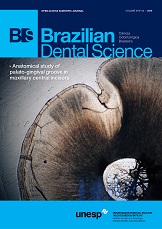Oral health in relation to nutritional status, age and sex among 14-18 years children of Naraingarh, Haryana
DOI:
https://doi.org/10.14295/bds.2015.v18i3.1127Abstract
Objective: To describe prevalence dental caries and to study the association between nutritional status and oral health based on various indices among adolescents from under privileged communities. Material and Methods: The study was based on a cross-sectional sample of 196 apparently healthy children (104 males and 92 females) in the age range of 14 to 18 years belonging to under-privileged communities. Each subject was measured for height, body weight to assess nutritional status and clinically observed for various oral health traits like dental caries, plaque, calculus and gingivitis. Results: Decayed, missing due to caries and filled teeth (DMF) index was low among adolescent children; it was 0.48 in males and 0.93 in females. Prevalence of calculus was higher among females through all age groups, while prevalence of plaque was higher among males. Sex differences were significant only for plaque index and DMF index. The inadequacy of nutrition was not a major determinant for the observed magnitude of soft deposits, plaque and calculus indices except for Oral health status index and DMF index where higher magnitude of the indices were observed in underweight children than the normal. Conclusion: The inadequate nutritional status was not a major determinant of oral health indicating the general awareness of oral hygiene and its observance was a major factor. Females were more prone to dental caries than the males and the severity was also significantly higher in the former.
Keywords
Oral health; Nutritional status; BMI-for-age Z-scores; Periodontal health indices; Adolescence
Downloads
Downloads
Published
How to Cite
Issue
Section
License
Brazilian Dental Science uses the Creative Commons (CC-BY 4.0) license, thus preserving the integrity of articles in an open access environment. The journal allows the author to retain publishing rights without restrictions.
=================




























